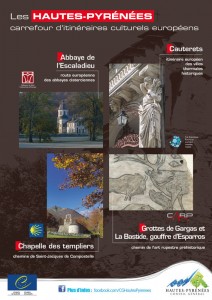In line with its approach of increasing appreciation of Heritage while at the same time placing it firmly in a 21st century context, the Departement of the Hautes Pyrenees (Conseil Général des Hautes-Pyrénées) has undertaken an important European Council Cultural Activity Project.
The cultural routes of the Council of Europe demonstrate the extent to which different European countries and cultures represent a shared cultural heritage.
In addition, the cultural routes are also a concrete illustration of the fundamental principles of the Council of Europe: human rights, cultural democracy, diversity and intercultural dialogue, and mutual exchange and enrichment across borders and centuries.
The European Route of Cistercian Abbeys, coordinated around Escaladieu Abbey, was approved by the Steering Committee for Culture of the Council of Europe on 7 June 2010.
With the support of the European Charter of Cistercian Abbeys and Sites, a cultural and tourist association constituted under the law of 1901, the European Route of Cistercian Abbeys, a cultural route of the Council of Europe, brings together nearly 200 Cistercian sites – three are listed as UNESCO heritage sites – spread throughout 11 European countries, from Portugal to Poland, from Italy to Sweden.

